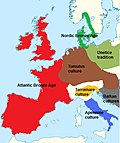 | Scytho-Siberian world (redirect from Scytho-Siberian culture) Sarmatian cultures of Eastern Europe, the Saka-Massagetae and Tasmola cultures of Central Asia, and the Aldy-Bel, Pazyryk and Tagar cultures of south Siberia... 63 KB (7,323 words) - 08:14, 27 April 2024 |
 | Natalia V. (20 September 2018). "Maternal genetic features of the Iron Age Tagar population from Southern Siberia (1st millennium BC)". PLOS ONE. 13 (9)... 67 KB (6,944 words) - 20:08, 13 May 2024 |
67°38′42″E / 53.303°N 67.645°E / 53.303; 67.645 The Botai culture is an archaeological culture (c. 3700–3100 BC) of prehistoric northern Central Asia. It... 23 KB (2,199 words) - 08:11, 27 April 2024 |
 | Kurgan hypothesis (redirect from Kurgan culture) prehistoric cultures, including the Yamnaya (or Pit Grave) culture and its predecessors. In the 2000s, David Anthony instead used the core Yamnaya culture and... 34 KB (3,825 words) - 14:41, 30 April 2024 |
 | The Hallstatt culture was the predominant Western and Central European archaeological culture of the Late Bronze Age (Hallstatt A, Hallstatt B) from the... 76 KB (8,518 words) - 22:15, 5 May 2024 |
Unetice culture, Ottomány culture, British Bronze Age, Argaric culture, Nordic Bronze Age, Tumulus culture, Nuragic culture, Terramare culture, Urnfield... 27 KB (3,038 words) - 04:35, 9 April 2024 |
reused more than a millennium later in the Scythian-era kurgans of Tagar Culture. Okunev stone stela collections are displayed in the Khakassia National... 54 KB (5,767 words) - 08:15, 1 March 2024 |
 | Jōmon period (redirect from Jomon Culture) hunter-gatherer and early agriculturalist population united through a common Jōmon culture, which reached a considerable degree of sedentism and cultural complexity... 52 KB (5,851 words) - 16:44, 28 April 2024 |
 | Indus Valley Civilisation (redirect from Indus Valley Culture) and later cultures called Early Harappan and Late Harappan in the same area. The early Harappan cultures were populated from Neolithic cultures, the earliest... 187 KB (21,242 words) - 18:15, 13 May 2024 |
culture nevertheless displays influences from the earlier Afanasievo culture. The region was subsequently occupied by the Andronovo, Karasuk, Tagar and... 62 KB (6,043 words) - 04:42, 11 May 2024 |
The Armorican Tumulus culture is a Bronze Age culture, located in the western part of the Armorican peninsula of France. It is known through more than... 16 KB (1,721 words) - 01:53, 24 March 2024 |
 | khovo Sha- jing Subeshi Slab-grave culture DONGHU SABEANS Ordos culture Pazyryk Tagar Chandman Sagly JIN Dian culture MACEDONIAN EMPIRE NANDA EMPIRE ZHOU... 38 KB (4,312 words) - 21:06, 2 May 2024 |
The Canegrate culture was a civilization of prehistoric Italy that developed from the late Bronze Age (13th century BC) until the Iron Age, in the areas... 13 KB (1,455 words) - 07:57, 8 April 2024 |
 | South-Western Iberian Bronze (category Archaeological cultures of Europe) Chalcolithic but already with individual burials. Influenced by the culture of Vila Nova de São Pedro. Horizon of Atalaia (c. 1500–1100 BCE): that introduces... 13 KB (1,041 words) - 10:26, 30 August 2023 |
Novocherkassk culture north of the Black Sea. There are also connections with the Bainov phase of the Tagar culture and the early Majemir culture of the Altai... 35 KB (3,929 words) - 01:18, 21 April 2024 |
Unetice culture Bronze Age Britain Armorican Tumulus culture Polada culture Pyrenean Bronze Ottomány culture Wietenberg culture Tumulus culture Nordic... 7 KB (599 words) - 17:20, 14 April 2024 |
 | Saka (redirect from Saka culture) the Tasmola culture were found to be of about 43% Sintashta ancestry, 50% Baikal_EBA ancestry and 7% BMAC ancestry. Tagar Sakas (Tagar culture) were found... 200 KB (21,796 words) - 18:48, 23 April 2024 |
 | The Apennine culture is a technology complex in central and southern Italy from the Italian Middle Bronze Age (15th–14th centuries BC). In the mid-20th... 10 KB (1,174 words) - 08:41, 18 March 2024 |











